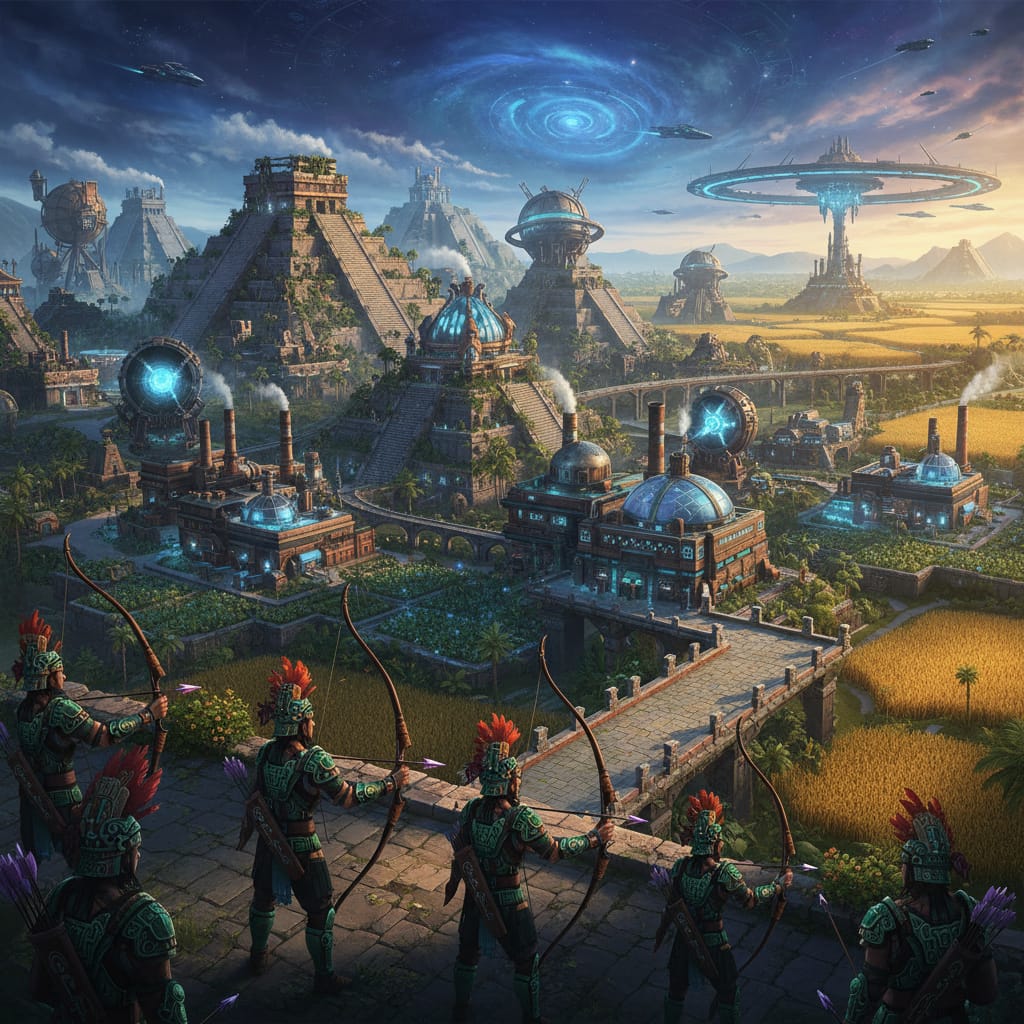The Mayan civilization, under the leadership of Lady Six Sky, presents one of the most intricate spatial puzzles in Civilization VI. Their entire strategy is dictated by a strict six-tile radius from the capital, forcing a unique “tall-but-wide” approach that rewards meticulous planning. Player communities have spent countless hours debating the optimal placement of eight, ten, or perhaps twelve cities to maximize the powerful yields granted within this golden circle. But what if the most fundamental rule of city placement—the minimum distance of four tiles between city centers—was simply removed for them? This single change would not just alter their strategy; it would shatter the known paradigms of expansion and yield generation, transforming the Mayans from a methodical science-focused civilization into an unstoppable engine of hyper-density.
The Unbound Metropolis: Rethinking the Mayan Core
The current Mayan meta-game revolves around a careful balancing act. Players must identify city locations that are within six tiles of the capital but also far enough apart to own a unique and productive set of tiles. This naturally limits the number of cities that can benefit from Lady Six Sky’s +10% yield bonus. Analysis on forums shows that the most effective layouts typically accommodate between eight and ten cities before running into significant tile overlap or being forced outside the critical six-tile ring, which incurs a steep -15% yield penalty.
If the minimum distance rule were abolished, this delicate balance would be replaced by a land rush of unprecedented density. The new objective would be to cram as many city centers as physically possible within the six-tile radius. Instead of cities being four tiles apart, they could be settled on adjacent tiles. This would allow a player to establish a core of 15, 20, or even more cities, all receiving the +10% yield bonus. The capital’s immediate ring of six tiles, normally reserved for districts and wonders, could itself become home to six new cities. Each of those cities would then project its own workable tile radius, creating a sprawling, overlapping megalopolis. This “Unbound Metropolis” would function less like a collection of distinct cities and more like a single, contiguous urban zone, fundamentally changing the very definition of a Mayan empire.
District Triangles and Quad-Clusters: A New Geometry of Yields
The true power of a hyper-dense Mayan core would be realized through an entirely new approach to district planning. Standard strategy involves placing districts to gain adjacency from terrain or other districts within the same city. With city centers on adjacent tiles, the geometry of adjacency bonuses would be completely redefined.
The Industrial Zone Quad-Cluster
A popular strategy is to create “Industrial Zone triangles” where one city’s factory provides power to two others. With no placement restrictions, this concept would be taken to its logical extreme. A player could settle four cities in a diamond formation, just two tiles apart from each other. In the center of this diamond, a single Industrial Zone could be placed. Once a Factory and Power Plant are built, this one district would provide its regional production bonus to all four surrounding cities simultaneously. This “Quad-Cluster” would create pockets of immense industrial power. An empire with three or four such clusters could produce units, buildings, and wonders at a rate that no other civilization could possibly match.
The Observatory Nexus
The Mayan unique Observatory district is already powerful, gaining science from adjacent Plantations and Farms. In a hyper-dense layout, its potential would become astronomical. Imagine a central tile with a Plantation resource. A player could settle three or four cities around it, each placing an Observatory directly adjacent to that single Plantation. Each Observatory would receive the +2 science bonus. Furthermore, the spaces between these Observatories and city centers would be filled with Farms. According to the player community, a well-placed Observatory can already achieve a +6 or +7 adjacency bonus. In this hypothetical scenario, it would be common to see multiple +10 or +12 Observatories packed together, sharing adjacencies from a central nexus of improvements and creating a feedback loop of scientific output that would leave competitors in the dust.
Economic Avalanche: The Farm and Plantation Revolution
The Mayan Mayab ability, which removes housing from water but adds +1 housing and +1 gold from every Farm, is the key that unlocks the potential of the Unbound Metropolis. In a standard game, this requires a significant investment in Builders and land to support population growth. In a hyper-dense scenario, it becomes the engine of an economic avalanche.
With cities packed shoulder-to-shoulder, almost every available land tile could be improved. The demand for housing would be astronomical, necessitating the creation of vast, unbroken fields of Farms. Each of these Farms would not only provide the +1 housing and +1 gold but would also contribute to the adjacency bonuses of multiple Observatories. This creates a perfect synergy: the need for population growth directly fuels scientific output. The sheer volume of gold generated by this sea of Farms would allow the Mayan player to purchase buildings, patronize Great People, and levy city-state armies with impunity.
Moreover, the ability to gain an amenity from luxury resources adjacent to the city center would be amplified. A single Plantation of cocoa or tobacco could be adjacent to two or even three city centers, providing its amenity bonus to each of them. This would make the Mayan empire incredibly happy, allowing for sustained growth and high yields, and freeing up multiple copies of luxury resources to be traded away for immense profit.
Military Implications: The Hul’che Swarm
The strategic implications extend deeply into military affairs. Lady Six Sky grants a +5 combat strength bonus to all units within six tiles of the capital. In our hypothetical scenario, the entire Unbound Metropolis—all 20+ cities and the units they produce—would exist within this zone of empowerment. This would create an almost impenetrable defensive core. An invading army would not be attacking a single city; it would be pushing into a dense fortress of overlapping city defenses and empowered units.
Many professional gamers suggest that the ability to quickly reinforce and heal units is a cornerstone of effective warfare. With adjacent city centers, a damaged unit could move one tile and be garrisoned, healing fully in a single turn. The production from the aforementioned Quad-Cluster Industrial Zones could be channeled into producing the Mayan unique unit, the Hul’che. The result would be a “Hul’che Swarm”—a nearly endless stream of powerful archers emerging from a dozen production centers at once. This defensive swarm could repel almost any conventional attack. Offensively, this dense core would serve as the ultimate staging ground, allowing a player to amass an overwhelming force before launching a decisive strike against a neighboring civilization.
Victory Path Dominance: A Hyper-Charged Science Game
A Mayan civilization with no city placement restrictions would be overwhelmingly favored for a Science Victory. The sheer concentration of high-adjacency Observatories would generate science-per-turn at a rate previously thought impossible. This scientific dominance would begin in the Classical Era and only accelerate from there.
The path to the stars would be paved by the synergy between science and production.
1. Early Game: The initial city cluster is established, and the first Observatory Nexuses are planned around plantation resources.
2. Mid Game: Industrial Zone Quad-Clusters come online. The immense production is used to quickly build Universities and Research Labs in every city. The gold from the Farm economy is used to purchase any missing buildings or to secure key Great Scientists.
3. Late Game: The player reaches the end of the tech tree decades or even centuries before any other civilization. The same production centers that churned out Hul’che now build Spaceports. The Royal Society building, which allows Builders to contribute to space projects, becomes incredibly powerful when you can produce Builders in a single turn.
While the Science Victory would be the most direct path, the economic and production might generated by the Unbound Metropolis could easily fuel other victory conditions. The gold and production could support a massive army for a Domination Victory or allow the player to become the suzerain of every city-state on the map for a Diplomatic Victory.
Counter-Strategies and Inherent Weaknesses
This strategy, while overwhelmingly powerful, would not be without its vulnerabilities. Analysis on forums shows that concentrating assets always creates concentrated risks. A single, well-placed spy with the “Sabotage Production” or “Disrupt Rocketry” missions could cripple an entire Quad-Cluster of Industrial Zones or a key Spaceport, respectively.
The greatest threat, however, would come from civilizations that excel at loyalty pressure, such as Eleanor of Aquitaine. The close proximity of cities could create a loyalty cascade. If one city were to flip, the pressure it exerts on its immediate neighbors would be immense, potentially leading to a domino effect that could unravel the entire metropolis from within.
Finally, in the late game, the hyper-density becomes a massive liability. A single bomber raid could damage districts in multiple cities at once. A well-placed Nuclear Device would be catastrophic, potentially wiping out half a dozen city centers and irradiating the heart of the empire in a single, devastating blow.
In conclusion, removing the city adjacency penalty for the Mayans would fundamentally break the game’s spatial logic. It would transform them from a civilization that plays “tall” into one that plays “dense,” creating an Unbound Metropolis that functions as a single, sprawling urban entity. The geometric possibilities for district clusters would generate unprecedented yields in science and production, fueling an economic and military avalanche. While not without its risks, this hypothetical change would elevate the Mayans to a tier of their own, offering a glimpse into a radically different and terrifyingly efficient way to play Civilization VI.


